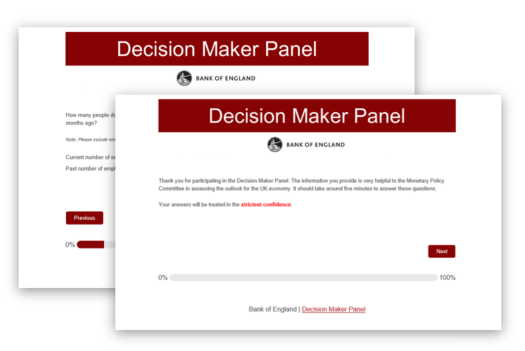All panel members are sent a link to an online survey, once a month. The survey takes around 5 – 10 minutes to complete and topics are rotated each month so that panel members answer questions from all topics across three months. These topics cover our regular questions and some special questions additionally, which have been prompted by our conversations with policymakers at the Bank of England and HM Treasury.
After three months, panel members receive the same regular questions again, referring to a different time period. The recurring nature of the questions allows us to understand how a business feels its conditions are changing over time. Special questions adjust to the immediate needs of policymakers and provide further insights for academic research.
Since August 2016, panel members have been asked regular questions on three topics
- Employment,
- Capital expenditure
- Sales and Prices.Decision makers are asked to provide five scenarios for each variable: from the worst case to the best case, and to specify how likely they think each scenario is.
EXAMPLE: We may present a question in which we ask you to make an estimate of expected sales growth over the next year in five different scenarios (see Fig. 1). The ‘lowest’ and the ‘highest’ scenarios would be the lowest or highest sales growth you think might be realistically possible. The ‘middle’ scenario would be the business-as-usual scenario, with the ‘low’ and ‘high’ scenarios then being in between the ‘middle’ and ‘lowest’ or ‘middle’ and ‘highest’ scenarios respectively.

Figure 2: Likelihood of the sales growth scenarios.
After answering this question, we then ask which probability you attach to each of those scenarios (see Fig. 2). The software we use will carry forward the values given from previous surveys, for example, the expected sales growth rates that you provided in different scenarios. There is no logical requirement for you to offer the same probabilities for each question, as you may have different views about the likelihood of different outcomes occurring. We prefer that you provide us with your best guess of the probability in each category, as long as the probabilities add up to 100.
Why do we ask about expectations in this way rather than asking for a single number? Answers in this ‘likelihood’ format give us information about the range of possibilities as anticipated by you, as well as a sense of how confident you are about the plausibility of those outcomes.
Questions included in other similar surveys ask for an ‘up’/’down’ or ‘stay the same’ prediction, but these have significant limitations. The DMP offers policymakers more detailed information about quantities – how much sales growth is expected to rise or fall – and the degree of uncertainty around those outcomes. Some studies ask only for the ‘middle’ outcome, but this can also be misleading. One company might place equal probability on five possible outcomes, while another company might be very confident about their predictions for their middle scenario and place 100% probability on that outcome. If we only collected the middle outcome, we would misrepresent the views of the first company.
In addition to the regular questions, participants are asked special questions, which so far have mostly concerned Brexit. At the end of each set of questions, there is a box where panel members are invited to leave a comment. You are encouraged to provide any additional information that you feel may help us understand your responses better. Policymakers have relayed to us that they greatly value the opportunity for respondents to provide the reasons for their answers. For example, information on whether a contraction in demand or supply lies behind your response can indicates an expected fall in sales revenue.
